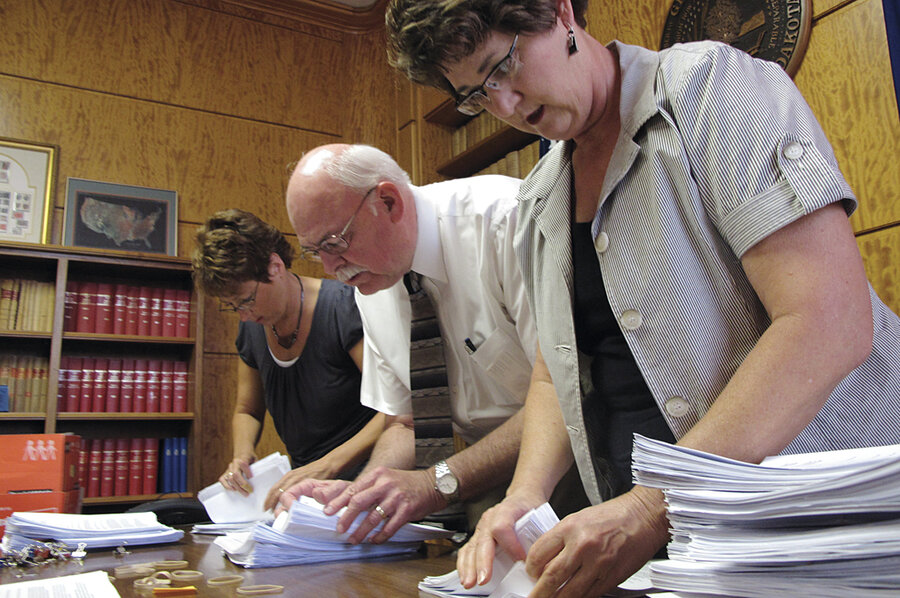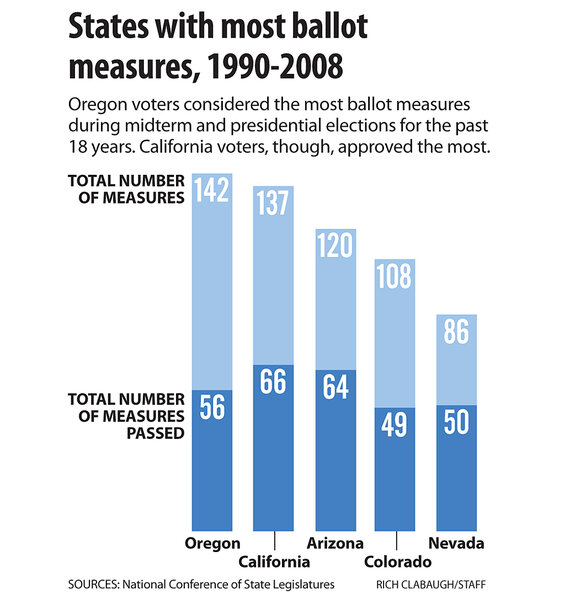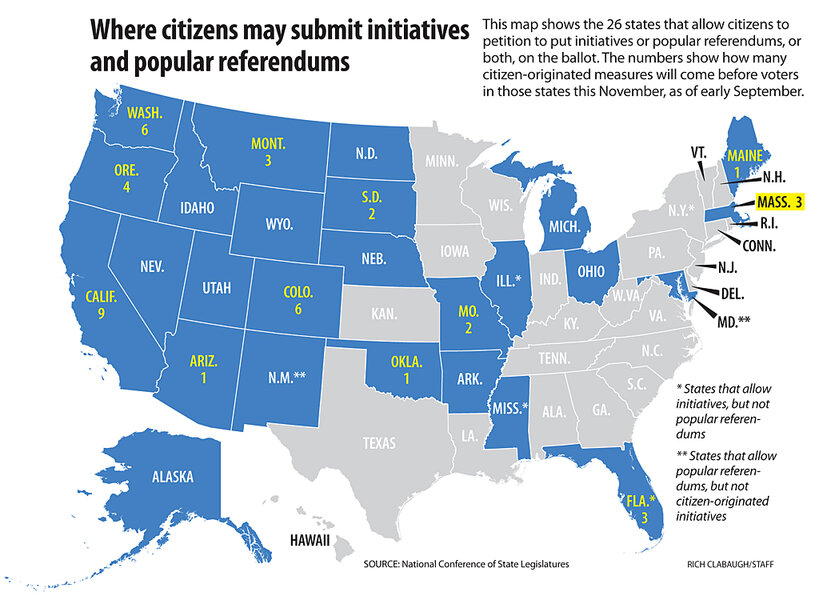Ballot measures 101: Will they boost voter turnout in Election 2010?
Loading...
Amid all the horse races, attack ads, and political gimmicks of the 2010 midterm elections, some states will actually get some policy done on Nov. 2. Those states have ballot measures up for a vote. These initiatives and referendums range from votes to confirm laws the state legislature has already passed to state constitutional amendments, and they cover an eclectic range of topics from marijuana legalization to abortion.
In a year marked by voters' dissatisfaction with politicians, ballot measures could be a gauge of which issues citizens are most eager to take into their own hands.
How many ballot measures will there be in November?
Citizens in 35 states will vote on at least 149 ballot questions in the November general election. It's too early to say the exact total of ballot measures, because state legislatures could still trigger additional referendums before they recess for good ahead of the election.
The deadline for citizen-initiated ballot measures, however, has already passed in all 26 states that have that process. Forty-two such measures have qualified for voter consideration.
In general, about 200 total ballot measures face voters in national election years, according to the National Conference of State Legislatures.
What are the different types of ballot questions?
There are two basic kinds of state ballot questions: referendums and initiatives. Referendums are votes of confidence in laws that have already been passed by a state legislature and signed by the governor. Certain actions, such as passing state constitutional amendments or bond measures, often trigger voter referendums automatically. All 50 states call for automatic referendums in some cases. However, citizens of 23 states can also petition for a referendum to overturn any law, provided they do so within a certain time frame after the law's passage. South Dakota has the only "popular referendum" of 2010: an effort to overturn the state's ban on smoking in casinos.
In addition to referendums, voters in a different group of 24 states can put initiatives on their ballots. (This group of 24 largely overlaps with the 23 states that have popular referendums, though they differ slightly.) While referendums are limited to subjects already taken up by a legislature, initiatives are completely set in motion by private citizens (a designation that includes interest groups and other powerful lobbies). If a group can gather the required number of signatures in support of its initiative by the state deadline, then its measure will appear on the state's ballot.
In general, what issues will be up for a vote this year?
For the most part, there is little state-to-state continuity in the jumbled mass of local tax and regulation issues that are the subjects of ballot measures this year. A large portion of them are about financing infrastructure projects and dealing with uniquely local problems. In Illinois, which was rocked by allegations that ex-Gov. Rod Blagojevich tried to sell an open US Senate seat in 2008, voters will get the chance to create a recall procedure for removing the governor, midterm, with a popular vote. Citizens of Rhode Island will determine the fate of a constitutional amendment to change the official name of the state. (It is currently "Rhode Island and the Providence Plantations.")
However, there are a few common threads between various states' ballot measures. In a challenge to the health-care reform law Congress passed earlier this year, residents of Arizona and Colorado will vote on state constitutional amendments to disallow mandatory participation in health insurance. Arizona and Colorado also join California and South Dakota with initiatives that would, to varying degrees, decriminalize marijuana. California's Proposition 19 is the most radical, mandating full legalization, while the others concern medical marijuana use. And with two-thirds of Americans concerned about government spending, according to an August Reuters/Ipsos poll, four states – Colorado, Florida, Oklahoma, and Washington – have ballot measures about limiting public borrowing and expenditures. The Florida question is a nonbinding resolution on whether the US Constitution should have a balanced-budget amendment.
In Iowa, Maryland, Michigan, and Montana, voters will decide whether to call a state constitutional convention. The states' current constitutions automatically trigger these ballot questions at certain intervals, and voters have never acted upon them. But "tea party" activism and general displeasure with the status quo might push some voters to consider a rare experiment with American democracy. The last state to rewrite its constitution in a popular convention was Louisiana, in 1973 and 1974.
What is the success rate of ballot measures?
In the past 10 general elections dating back to 1990, voters approved 1,204 of 1,943 measures that appeared on state ballots. That 62 percent success rate has stayed fairly constant. Only once in that period did fewer than half of the ballot measures pass: in the 1990 election, when 42 percent succeeded. The highest rate of ballot measure passage in that period was in 1998, when 175 of 236 proposed ballot questions – 74 percent – got voters' seal of approval.
Do ballot measures affect voter turnout?
In 2004, the Republican Party supported initiatives to outlaw gay marriage in a number of battleground states, in the hope that the hot-button social issue would entice evangelical members of the Republican base to turn out in greater numbers. Since then, there has been an element of political strategy to statewide ballot measures, with both parties trying to figure out which issues will motivate their strongest supporters to go to the polls. Studies by American political scientists show that ballot measures increase voter turnout, especially in nonpresidential elections, when citizens tend to be less engaged in election news.
However, it is unclear exactly who is motivated to vote by ballot measures. Earlier this year, Joshua Green of The Atlantic suggested that marijuana legalization initiatives in California and elsewhere might help Democratic candidates by boosting liberal turnout in the general election. But even though signature-gathering suggests a certain level of popular support in favor of most initiatives, Mr. Green later noted that some ballot measures could motivate opponents more than supporters. Studies have not conclusively shown that one or the other is necessarily true.







